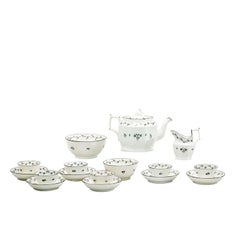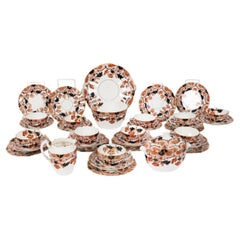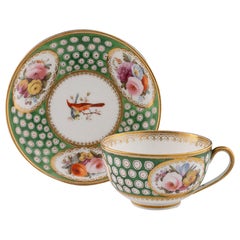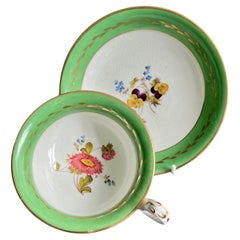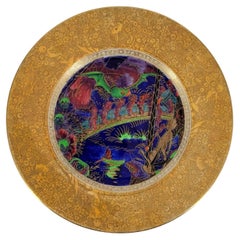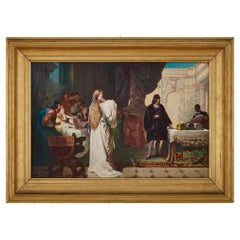British Porcelain
to
146
1,103
9
269
529
305
9
117
90
56
19
12
20
28
2
7
19
7
34
4
171
101
98
66
36
24
20
18
7
6
4
3
3
1,098
1,045
41
25
20
484
442
6,298
1,581
1,112
967
944
1,112
1,112
1,112
78
69
55
44
39
Place of Origin: British
18th Century Pearlware Tea Set with Swan Finial
By Wedgwood
Located in Great Barrington, MA
This 18th century rare and complete tea service for six is finely and simply decorated in the style of the period. The creamy white paste is hand-painted with black enamel decoration...
Category
19th Century Antique British Porcelain
Materials
Porcelain
$3,800 / set
Antique Clifton China 34 piece Tea Set By Wildblood & Heath 19th Century
Located in London, GB
This is a fine comprehensive 34 piece Clifton china antique porcelain tea set Made by Wildblood & Heath at the Peel Works Stafford Street in...
Category
Late 19th Century Antique British Porcelain
Materials
Porcelain
Nantgarw Porcelain Teacup and Saucer 1818-20
By Nantgarw China Works
Located in Tunbridge Wells, GB
Heading : Nantgarw porcelain teacup and saucer
Date : 1818-20
Period :Regency
Origin : Nantgarw, Wales. Possibly London decorated
Colour : Polychrome
Pattern : Three garden flower pa...
Category
1820s Regency Antique British Porcelain
Materials
Porcelain
H&R Daniel Teacup, Emerald Green Band and Hand Painted Flowers, ca 1830
By H&R Daniel
Located in London, GB
This is a very rare and beautiful teacup and saucer made by H&R Daniel some time around 1830. The set is potted in the plain variation on the "second gadroon" shape and is decorated ...
Category
1830s Rococo Revival Antique British Porcelain
Materials
Porcelain
Fairyland Plate - Roc Centre. Wedgwood, circa 1925
By Daisy Makeig-Jones, Wedgwood
Located in Melbourne, Victoria
A full-sized plate in bone china, with typical elaborate painted decoration known as Fairyland Lustre.
The Fairyland Lustre line was developed during a time when there was a strong...
Category
1920s Art Deco Vintage British Porcelain
Materials
Porcelain
Copeland Porcelain Plaque Depicting the Casket Scene from the Merchant of Venice
By Copeland
Located in London, GB
Copeland porcelain plaque depicting the Casket Scene from The Merchant of Venice
English, Late 19th Century
Frame: height 47.5cm, width 65.5cm, de...
Category
Late 19th Century Victorian Antique British Porcelain
Materials
Porcelain, Giltwood
Dursley Porcelain Dinner Set Decorated by James Skerrett
Located in London, GB
This dinner service by the porcelain manufacturers Dursley is hand painted by James Skerrett, a renowned British artist who has worked with some of the ...
Category
Late 20th Century British Porcelain
Materials
Porcelain
Conical form Teapot, Chelsea, circa 1755
By Chelsea Porcelain
Located in Melbourne, Victoria
An unusual shape, which looks impractical and yet the lid is surprisingly stable when the pot is tilted. The usual superb flower painting for this period.
See McKenna, Red Anchor ...
Category
Mid-18th Century Neoclassical Antique British Porcelain
Materials
Porcelain
$6,000 Sale Price
25% Off
Copeland Spode Dessert Set 8 Plates, 2 Square Plates Blue w/ Florals Butterfly
By Copeland Spode
Located in Great Barrington, MA
This set of 8 Copeland Spode dessert plates is accompanied by 2 matching square serving plates- Perfect for a cheese and fruit course as well as d...
Category
1920s Aesthetic Movement Vintage British Porcelain
Materials
Porcelain
Pair of Coalport Cabinet Plates Hand Painted, Frederick Chivers Still Life, 1910
Located in Dublin, Ireland
Stunning hand painted English Porcelain coalport pair of cabinet plates still life of fruits, hand decorated by Frederick Chivers, of outstanding quality...
Category
Early 20th Century Edwardian British Porcelain
Materials
Porcelain
Minton Porcelain "English Rose" Pattern Part Dinner Service, 20th Century
By Minton
Located in Ottawa, Ontario
A Minton porcelain 'English Rose'
pattern part dinner service
20th century.
Comprising nine dinner plates 10¾ in. (27.3 cm.) diameter.
Nine 6 1/8 in.(15.5cm.) bread and butter...
Category
Mid-20th Century International Style British Porcelain
Materials
Porcelain
Georgian Derby Coffee Can & Saucer John Stanesby hand painted roses, Circa 1810
By Royal Crown Derby Porcelain
Located in Lincoln, Lincolnshire
This is a beautiful porcelain coffee can and matching saucer by the Derby factory, made during the late Georgian period of the early years of the 19th Century
The cylindrical can ...
Category
Early 19th Century George III Antique British Porcelain
Materials
Porcelain
19th Century Derby Porcelain Figure Of John Falstaff The Merry Wives Of Windsor
By Derby Porcelain
Located in Dublin, IE
A very elegant 19th century Derby porcelain figure of the actor James Quinn (1693-1766) in the character of John Falstaff in The Merry Wives Of Windsor. Modelled by Farnsworth, based...
Category
19th Century Victorian Antique British Porcelain
Materials
Porcelain
Rare Victorian Porcelain Charger with Platinum Ground & Bronze Bamboo Rim
Located in Worcester, GB
A rare and decorative Victorian porcelain charger, attributed to Minton, England, circa 1875–1890. The central field is exquisitely hand-painted with butterflies, a dragonfly, and fl...
Category
Late 19th Century Antique British Porcelain
Materials
Bronze, Enamel
12 Royal Doulton "Powder Blue" W/ Raised Gold Dinner Plates
By Royal Doulton
Located in Great Barrington, MA
These aren't the typical set of dinner plates from Royal Doulton. This set of 12 are decorated with thick raised paste gold over a "lapis lazuli" type of decoration which distinguish...
Category
Early 20th Century Neoclassical British Porcelain
Materials
Porcelain
19th C. Ashworth Soup Tureen and Stand/Underplate
By Ashworth Ironstone
Located in Great Barrington, MA
Stunning Ashworth soup tureen with lid and underplate in deep cobalt with floral decoration and gilded accents. This pattern is both classic yet ...
Category
19th Century Antique British Porcelain
Materials
Porcelain
Miles Mason Coffee Can & Saucer Porcelain Chinamen on Verandah Pattern, Ca 1805
By Miles Mason Porcelain
Located in Lincoln, Lincolnshire
This is a Miles Mason Duo of two pieces of blue and white hand gilded porcelain comprising a coffee can and a saucer, all in the Chinaman on Verandah pattern, made by Miles Mason (Ma...
Category
Early 19th Century Chinoiserie Antique British Porcelain
Materials
Porcelain
Near Pair of Baluster Shape Vases, Chelsea, circa 1755
By Chelsea Porcelain
Located in Melbourne, Victoria
Baluster shaped vase in soft paste porcelain with early gilt line decoration. Superb flower painting.
The shapes are very close, and the gilding is slightly more elaborate on the se...
Category
Mid-18th Century Neoclassical Antique British Porcelain
Materials
Porcelain
Staffordshire Ironstone Plate
Located in Clearwater, FL
This exquisite ironstone plate by Francis Morley & Co. of Staffordshire features the intricate Zamara pattern in a rich deep pink, accented with touches of blue, green, and yellow. W...
Category
1840s Antique British Porcelain
Materials
Ironstone
Daisy Makeig-Jones Wedgwood Ruby Lustre Decorative Bowl
By Daisy Makeig-Jones, Wedgwood
Located in Fort Lauderdale, FL
A Wedgwood ruby lustre bowl decorated with gilded butterflies, designed by Daisy Makeig-Jones circa 1915.
Delicately gilded butterflies decorate this bowl's exterior atop a deep ru...
Category
1910s Art Deco Vintage British Porcelain
Materials
Porcelain
Fairyland Lustre Bowl, Geisha Wedgwood, circa 1925
By Wedgwood, Daisy Makeig-Jones
Located in Melbourne, Victoria
An octagonal fairyland lustre bowl, decorated with Geisha pattern, one of the best loved of Daisy Makeig-Jones’ designs.
Probably the best of Wedgwood's female designers, Daisy wa...
Category
1920s Art Deco Vintage British Porcelain
Materials
Porcelain
11 Aesthetic Movement Minton Hand Painted Botanical Dessert Plates Butterflies
By Minton
Located in Great Barrington, MA
This set of 11 Minton hand painted dessert plates is a wonderful example of the artistry of the Aesthetic Movement. Dated 1881, these depict the co...
Category
1880s Aesthetic Movement Antique British Porcelain
Materials
Porcelain
12 Royal Worcester Hand-Painted Dessert Plates with Fruit Artist Signed Hummel
By Royal Worcester
Located in Great Barrington, MA
This set of 12 Royal Worcester dessert plates depicting central decoration of various fruits are all hand colored and signed by the artist. The...
Category
1950s Vintage British Porcelain
Materials
Porcelain
20th Century Rare Royal Doulton Toby Jug
Located in Dublin 8, IE
20th Century rare Royal Doulton toby jug depicting Jan Christian Smuts (1870-1950), a South African statesman in his Field Marshal’s uniform. Mo...
Category
20th Century British Porcelain
Materials
Porcelain
Four-Piece Jasperware Wedgwood Set, c. 1950's
By Wedgwood
Located in Los Angeles, CA
Elegant four-piece set of jasperware vases by Wedgwood with great detail all around depicting classical imagery/scenes and botanical figures.
Made in England, c. 1950's. Signed "Wed...
Category
1950s Vintage British Porcelain
Materials
Ceramic
$1,600 / set
Royal Worcester George Owen Reticulated Beadwork Cup and Saucer
By George Owen
Located in Bishop's Stortford, Hertfordshire
A stunning and rare antique Royal Worcester reticulated cup and saucer decorated with beadwork and painted designs by renowned and sought after potter George Owen (British, 1845-1912...
Category
1880s Aesthetic Movement Antique British Porcelain
Materials
Porcelain
19th Century Majolica Minton Fish Plate Oyster Plate
By Minton
Located in Atlanta, GA
Beautiful and rare Majolica Minton plate is the perfect piece to add to your collection.
Category
Mid-19th Century Victorian Antique British Porcelain
Materials
Porcelain
Samuel Alcock Teacup Trio, Very Fine Hand Painted Landscapes, ca 1831
By Samuel Alcock & Co.
Located in London, GB
A beautiful "true trio" consisting of a teacup, a coffee cup and a saucer, with a white ground, cobalt blue and gilt rims and very fine hand painted landscapes.
Pattern 3649
Year: c...
Category
1830s Rococo Revival Antique British Porcelain
Materials
Porcelain
Samuel Alcock Footed Comport, Embossed, White with Passion Flower, ca 1824
By Samuel Alcock & Co.
Located in London, GB
A footed rectangular central comport or centre piece, embossed shape with rope handles; white with scattered white passion flowers and gilt handles.
Pattern 1061
Year: ca 1824
Size:...
Category
1820s Regency Antique British Porcelain
Materials
Porcelain
Christopher Dresser Aesthetic movement Japonism style Pink Minton Plate 1876
By Minton, Christopher Dresser
Located in Paris, FR
Pink Aesthetic Minton Porcelain plate in the style of Japonism creations made by Christopher Dresser. Round plate adorned with an oriental fan representing a lovely and colorful bird...
Category
Late 19th Century Aesthetic Movement Antique British Porcelain
Materials
Porcelain
Royal Crown Derby Mug
By Royal Crown Derby Porcelain
Located in New York, NY
Royal crown derby mug, dated 1944.
Artist signed W.E.J. Dean.
Category
20th Century British Porcelain
Materials
Porcelain
$5,500
Pair of 19th Century Hand-Painted Spode Sauce Tureens
By Spode
Located in Great Barrington, MA
This is a special pair of 19th C, Spode sauce tureens with matching attached underplates and handles. The raised molded relief depicting pheasants ...
Category
19th Century Antique British Porcelain
Materials
Porcelain
Nantgarw Porcelain Teacup and Saucer c1820
By Nantgarw China Works
Located in Tunbridge Wells, GB
Heading : Nantgarw porcelain teacup and saucer
Date : 1818-20
Period :Regency
Origin : Nantgarw, Wales. Probably London decorated
Colour : Polychrome
Pattern : Three garden flower pa...
Category
1820s Regency Antique British Porcelain
Materials
Porcelain
Set of 12 Royal Crown Derby Hand-Painted Dinner Plates with Floral Bouquets
By Royal Crown Derby Porcelain
Located in Great Barrington, MA
This set is a great example of the iconic artistry and style of Royal Crown Derby.
These plates are embellished with swags of vibrant hand-painted roses and two bands of acid etched...
Category
Early 1900s Antique British Porcelain
Materials
Porcelain
Antique 19th Century English Hound’s Head Porcelain Stirrup Cup with Stand
Located in Chicago, IL
Antique 19th century English porcelain stirrup cup in the shape of a hound’s head. Stirrup cups were used in England for hunting with dogs, for a drink before the hunt while the hunt...
Category
19th Century Victorian Antique British Porcelain
Materials
Porcelain
Shelley Art Deco Coffee/Espresso Set for 4 Trees with Sun Shining
By Shelley Pottery
Located in Great Barrington, MA
This is a classic early Shelley design with an Art Deco aesthetic. It includes the following pieces all in excellent condition.
4 Cups, 2.5" x 2.5", 4 Saucers, 4.5" x 0.5", 1 Crea...
Category
1910s Art Deco Vintage British Porcelain
Materials
Porcelain
Round Majolica Tray in Glazed Ceramic
Located in Lisboa, Lisboa
This elegant round Majolica tray, crafted in Europe during the 20th century, features a beautifully glazed ceramic surface with vibrant polychrome floral motifs. The delicate floral ...
Category
1930s Mid-Century Modern Vintage British Porcelain
Materials
Ceramic
Unusual antique Royal Worcester loving cup
Located in Ipswich, GB
Unusual antique Royal Worcester loving cup, having an unusual large antique Royal Worcester loving cup with a pair of shaped handles to the sides, decorated with beautiful flowers in...
Category
Early 20th Century British Porcelain
Materials
Porcelain
Minton Dessert Service, Inverted Shell White with Monochrome Flowers, ca 1830
By Minton
Located in London, GB
This is a stunning dessert service made by Minton probably around the year 1830, in their "second period". The service consists of a high footed centre piece, two square dishes, two ...
Category
1830s Rococo Revival Antique British Porcelain
Materials
Porcelain
English Blue and White Ironstone Tableware, Transfer Bowl by Cauldon Messina
Located in Miami, FL
A very good quality antique transfer plate or serving bowl by Cauldon Messina.
English blue and white Delft style porcelain.
Great for all occasio...
Category
Late 19th Century Victorian Antique British Porcelain
Materials
Porcelain
Victorian pate-sur-pate white and blue porcelain plaque by Cope
Located in London, GB
Victorian pate-sur-pate white and blue porcelain plaque by Cope
English, c. 1880
Height 20cm, width 30.5cm, depth 0.5cm
This charming and delicate pate-sur-pate by J. H. Cope & Co. depicts a fête galante...
Category
Late 19th Century Victorian Antique British Porcelain
Materials
Porcelain
Doulton Burslem Mint Green Hot Chocolate Set for 4 Gilt Gold & White Enamel
By Doulton Burslem
Located in Great Barrington, MA
This is a rare shape and specialized set that features beautiful cups with stylized handles unique to hot chocolate cups. Chocolate was a rare and e...
Category
Early 1900s Antique British Porcelain
Materials
Porcelain
Wedgwood Black Basalt Pastille Burner
By Wedgewood
Located in New Orleans, LA
Wedgwood began crafting pastille burners in the early nineteenth century, and this stunning dolphin burner is a gorgeous example of his innovative desi...
Category
19th Century Antique British Porcelain
Materials
Ceramic
Set of Antique Coalport Porcelain Dinner Plates Depicting English Fish
By Coalport Porcelain
Located in London, GB
Set of antique coalport porcelain dinner plates depicting English fish.
English, late 19th century
Dimensions: Height 2cm, diameter 22cm
...
Category
Late 19th Century Antique British Porcelain
Materials
Porcelain
Wedgwood Rosso Antico Egyptian Revival Teapot
By Wedgwood
Located in Sarasota, FL
Wedgwood Rosso Antico Egyptian Revival Teapot. The teapot surmounted by figural black crocodile finial, radiating ribbed lid, body decorated with Egypti...
Category
Early 19th Century Egyptian Revival Antique British Porcelain
Materials
Porcelain
Fine Coalport Porcelain Punch Bowl C.1820
By Coalport Porcelain
Located in Exeter, GB
A fine Coalport porcelain punch bowl c.1820. Decorated with panels of flowers on a rich cobalt blue ground with richly embelished gilt decoration:
...
Category
19th Century Antique British Porcelain
Materials
Porcelain
$1,346 Sale Price
20% Off
12 Cauldon B W & M Hand-Painted Botanical Dessert Plates Artist Signed
By Cauldon
Located in Great Barrington, MA
This set of 12 Cauldon/Brown Westhead and Moore dessert plates are decorated with the most elaborate and finely hand-painted botanical motifs. The cobalt blue ground frames the centr...
Category
Early 1900s Antique British Porcelain
Materials
Porcelain
Antique 19th Century Hand Painted and Gilt Porcelain Covered Center Bowl, Tureen
Located in Lambertville, NJ
Beautiful hand painted and hand gilt round and broad urn with lid. the floral decoration with gilt handles, original lid with delicate vine decoration all over. There are ladybugs, b...
Category
1880s Victorian Antique British Porcelain
Materials
Porcelain
Set of 13 Minton Dinner Plates Soft Blue Green Raised Paste Gold Leaf Pattern
By Minton
Located in Great Barrington, MA
This set of 13 Minton dinner plates feature the iconic "Eau de Nils" enamel border which is a soft blue green, described as the "wat...
Category
Early 20th Century Arts and Crafts British Porcelain
Materials
Porcelain
First Period Dr. Wall Worcester Porcelain Teapot Stand Fisherman Ptn, Circa 1775
By 1st Period Worcester Dr. Wall
Located in Lincoln, Lincolnshire
This is a very good 18th century, First period (Dr. Wall), Worcester porcelain teapot stand, printed in cobalt blue with the "Fisherman" pattern and with a mock oriental or painters ...
Category
18th Century George III Antique British Porcelain
Materials
Porcelain
Set of 12 Derby 1830 Rimmed Soup Bowls with Turquoise, Gilt & Floral Centers
By Derby Porcelain
Located in Great Barrington, MA
These are a wonderful example of the fine artistry of Derby Porcelain. What is especially amazing is that all 12 have survived for almost 200 years! The lovely floral centers are sur...
Category
1830s Antique British Porcelain
Materials
Porcelain
Set of Nine Minton 19th Century Hand-Painted Dessert Plates, Antonin Boullemier
By Minton
Located in Great Barrington, MA
This amazing set of nine Mintons, 19th century cabinet plates depicting young nymphs in fanciful, bucolic settings are beautifully and realistically painted on a soft aqua background...
Category
Late 19th Century Aesthetic Movement Antique British Porcelain
Materials
Porcelain
19th Century Worcester Hand-Painted Turquoise Partial Dessert Set
By Royal Worcester
Located in Great Barrington, MA
This unusual dessert service consists of six plates and two matching footed compotes with amazingly intricate pierced borders. Each piece is uniquely hand painted with flowers and shells and embellished in gold. The reserves are painted with a soft turquoise ground creating a dramatic contrast to the polychrome enamels and each piece is highlighted with an finely painted "M" monogram. The two matching footed compotes are a brilliant addition to the grouping for serving and display. They were made by Worcester...
Category
19th Century Antique British Porcelain
Materials
Porcelain
Set of 12 Coalport White Shaped Rim Dinner Plates with Handpainted Roses
By Coalport Porcelain
Located in Great Barrington, MA
This set of 12 dinner plates were made by Coalport in 1889 and retailed by Gilman Collamore, New York. Evoking the colors and style of Sevres porcelain, they have shaped rims with mo...
Category
1880s Antique British Porcelain
Materials
Porcelain
Chamberlains Worcester Porcelain Dish, Nelson or Fine Old Japan pattern, ca 1805
By Chamberlains Worcester
Located in London, GB
This is a striking square serving dish made by Chamberlains in Worcester around 1805. The dish bears the Fine Old Japan pattern, often called the Nelson pattern.
Robert Chamberlai...
Category
Early 1800s Georgian Antique British Porcelain
Materials
Porcelain
Pair of 19th Century Staffordshire Scottish Highlander Hunters
By Staffordshire
Located in Rio Vista, CA
Handsome pair of 19th century equestrian Staffordshire porcelain Scottish Highlander hunters on horseback. Each bearded gentleman is depicted seate...
Category
19th Century Edwardian Antique British Porcelain
Materials
Porcelain
$1,100 Sale Price / set
38% Off
Nantgarw Porcelain Teacup and Saucer 1818-20
By Nantgarw China Works
Located in Tunbridge Wells, GB
Heading : Nantgarw porcelain teacup and saucer
Date : 1818-20
Period :Regency
Origin : Nantgarw, Wales. Possibly London decorated
Colour : Polychrome
Pattern : Three garden flower pa...
Category
1810s Regency Antique British Porcelain
Materials
Porcelain
Antique 21 piece Royal Albert Crown China Porcelain Tea Set 20th Century
Located in London, GB
This is a wonderful Antique Royal Albert Crown china porcelain tea set, circa 1917 to 1925.
It contains 21 pieces and is beautifully made with superb gilded decoration in Cobalt and Rust floral design.
The initials "T.C.W" were part of the backstamp on Royal Albert china...
Category
Early 20th Century British Porcelain
Materials
Porcelain
Derby Porcelain Botanical Comport Pattern 216 c1795
By Derby
Located in Tunbridge Wells, GB
Heading : Derby Porcelain botanical comport pattern 216
Date : c1795
Period : George III
Marks :Double China Hollyhock above Derby Crown and Crossed Swords and pattern number 216
Ori...
Category
1790s George III Antique British Porcelain
Materials
Porcelain
$1,434 / item
Set of 12 Spode Newstone Aesthetic Movement Japanese Garden Soup Bowls Ca. 1840
By Spode
Located in Great Barrington, MA
This is an amazing set of 12 rimmed soup bowls marked "Spode's New-Stone" dating to 1840 but in like new condition. The "Japonesque" transfer decoration is embellished with hand pain...
Category
1840s Japonisme Antique British Porcelain
Materials
Ironstone
Recently Viewed
View AllMore Ways To Browse
Coalport Botanical
Copeland Dessert
Cornflower Porcelain
Derby Bloor
Du Paquier
Earl Of Shrewsbury
English Porcelain Birds
Fischer And Mieg
Glass Russian Double Headed Eagle
Gold Royal Worcester
Gold Scalloped Plates
Grainger Worcester
Hammersley Porcelain
Illy Cups
Japanese Coffee Pot
Klemm Dresden
Kpm Berlin Vase
Lagardo Tackett Schmid
